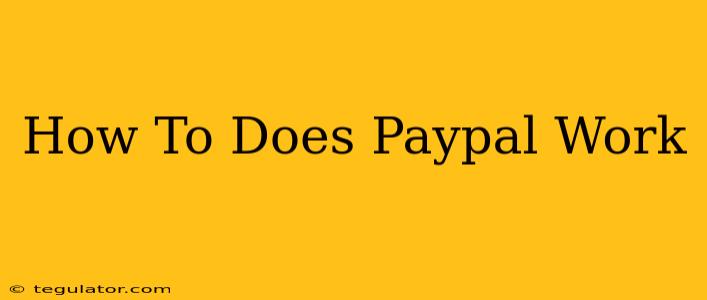PayPal is a ubiquitous online payment system, but how does it actually work? Understanding the mechanics behind PayPal can enhance your online shopping and financial transactions. This guide breaks down the process, addressing common questions and concerns.
Understanding the Basics of PayPal
At its core, PayPal acts as an intermediary between buyers and sellers. It facilitates online transactions by securely transferring funds between accounts without directly exposing your financial information. This offers a layer of protection compared to using debit or credit cards directly on many websites.
Key Features of PayPal:
- Secure Transactions: PayPal employs robust security measures to protect user data and funds. This includes encryption and fraud prevention systems.
- Buyer Protection: PayPal offers buyer protection programs to cover unauthorized purchases or items significantly different from their description.
- Seller Protection: Similarly, sellers are offered protection against fraudulent transactions or chargebacks.
- Wide Acceptance: PayPal is accepted by millions of businesses worldwide, making it a convenient payment option for both buyers and sellers.
- Global Reach: You can send and receive money internationally using PayPal, making it a versatile tool for global commerce.
How PayPal Works: A Step-by-Step Guide
Let's walk through a typical online purchase using PayPal:
-
Adding Funds: You can fund your PayPal account via linking a bank account, debit card, or credit card. Funds are typically transferred instantly or within a few business days, depending on the method.
-
Selecting PayPal at Checkout: When shopping online, select PayPal as your payment method at the checkout.
-
Logging into PayPal: You'll be redirected to the PayPal website or app to log in to your account.
-
Confirming Payment: Review the transaction details (amount, seller, etc.) and confirm the payment. You can choose to pay from your PayPal balance, linked bank account, or credit/debit card.
-
Transaction Completion: Once the payment is confirmed, PayPal will notify both the buyer and seller. The seller receives the funds, and the buyer receives a confirmation of purchase.
Sending and Receiving Money Between Individuals
PayPal isn't just for online shopping; it also allows you to send and receive money from friends and family, or even settle invoices. The process is similar to making an online purchase, but instead of a merchant, you'll enter the recipient's email address or mobile phone number.
Security Measures and Fraud Prevention
PayPal employs various security measures to protect its users:
- Two-Factor Authentication: Adding an extra layer of security by requiring a code from your phone or email in addition to your password.
- Fraud Monitoring: PayPal constantly monitors transactions for suspicious activity and takes action to prevent fraudulent transactions.
- Buyer and Seller Protection Policies: These policies help resolve disputes and protect users from scams or unauthorized transactions.
Addressing Common Concerns
-
Fees: PayPal charges fees for certain transactions, particularly for sending money internationally or receiving payments from customers. It's important to understand these fees before using the service.
-
Account Limits: PayPal may place limits on your account based on your transaction history and verification status.
-
Dispute Resolution: If a dispute arises, PayPal offers a dispute resolution system to help buyers and sellers resolve issues fairly.
Conclusion
PayPal offers a convenient and secure way to manage online transactions, both for shopping and personal money transfers. By understanding how it works and utilizing its security features, you can maximize the benefits of this popular online payment system. Remember to always review transaction details and stay informed about PayPal's policies and fees.

